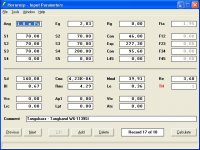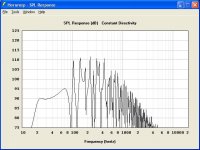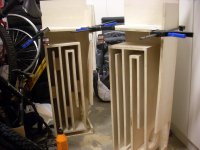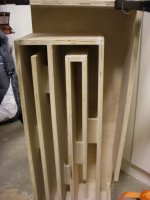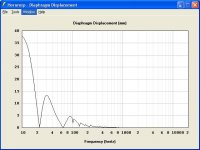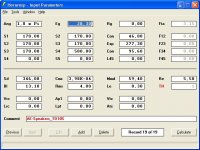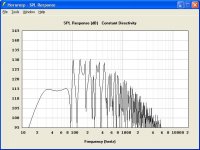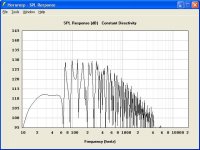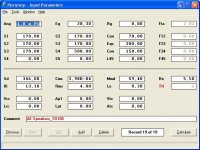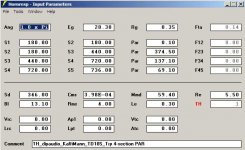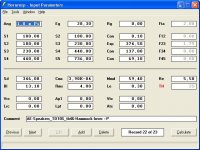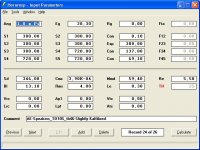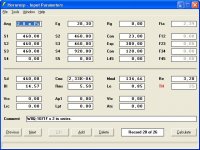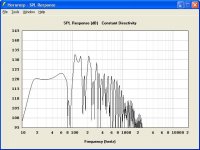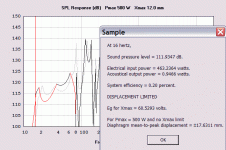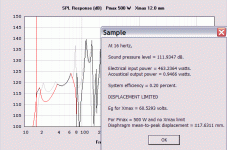Hi Patrick
“It looks like JL Audio discovered the tapped horn, and patented it:”
Well it is familiar looking but this is a series band pass speaker which uses a Helmholtz resonator(s).
A Tapped horn depends on the quarter wavelength resonator and what one would see is the path length would be much longer and rear volume MUCH smaller as well as some kind of horn loading in front of the connection.
The notable differences between the two types being that the quarter wave stub exhibits about half the phase shift of the phase inverter / Helmholtz resonator / ported box and does not exhibit the normal “low pass” acoustic filter of the filter used in that design.
There are similarities in a lot of things, for example, put a driver in a sealed box and you have a speaker, drill a hole in the box and you have a vented box. But if you use the right driver parameters, box volume and hole size, you have a T&S alignment, a design.
The Tapped horn is similar, it depends on having all of the conditions met in order to work properly, when that is done, one can occasionally raise the drivers inherent sensitivity by 10 dB or more.
It may look similar to designs from the past or ancient past but I am absolutely sure that if the details / strategy needed to build them had been known, it is absurd to suggest everyone simply ignored such a strong tool up to now.
I first started fiddling with the idea for these about 12 years ago when I was working on the Unity speakers, I wondered what would happen if is substituted a source of the opposite polarity for the returning reflection from the closed end of the horn.
About 7 years ago I was working on the new version of the Unity, the Synergy horns and went back to that idea. I laid one out in Akabak, after a couple weeks of fiddling in the computer, I made one, fixed the model and designed another one.
I found what some design rules were and by then the Tapped horns could become products that out performed what they competed against.
It was obvious the approach had strong merit; I applied for a patent based on what I knew at the time.
Now if one searched “Tapped Horn” one finds that in just 5-6 years, the term is near ubiquitous and many people are building them, even several companies.
Now, the patent has not issued, there is no protection at all until then and no guarantee it will issue anyway, but hey, that’s how it is with patents. I have a comparatively small company with a partner, we cannot compete with the large companies in marketing budget, the only way we can compete is on the strength / sound of our products and designs, they do not deserve to be chosen if they don’t win the audition or side by side comparisons.. Those do suggest the Tapped horn design is something new.
Best,
Tom
“It looks like JL Audio discovered the tapped horn, and patented it:”
Well it is familiar looking but this is a series band pass speaker which uses a Helmholtz resonator(s).
A Tapped horn depends on the quarter wavelength resonator and what one would see is the path length would be much longer and rear volume MUCH smaller as well as some kind of horn loading in front of the connection.
The notable differences between the two types being that the quarter wave stub exhibits about half the phase shift of the phase inverter / Helmholtz resonator / ported box and does not exhibit the normal “low pass” acoustic filter of the filter used in that design.
There are similarities in a lot of things, for example, put a driver in a sealed box and you have a speaker, drill a hole in the box and you have a vented box. But if you use the right driver parameters, box volume and hole size, you have a T&S alignment, a design.
The Tapped horn is similar, it depends on having all of the conditions met in order to work properly, when that is done, one can occasionally raise the drivers inherent sensitivity by 10 dB or more.
It may look similar to designs from the past or ancient past but I am absolutely sure that if the details / strategy needed to build them had been known, it is absurd to suggest everyone simply ignored such a strong tool up to now.
I first started fiddling with the idea for these about 12 years ago when I was working on the Unity speakers, I wondered what would happen if is substituted a source of the opposite polarity for the returning reflection from the closed end of the horn.
About 7 years ago I was working on the new version of the Unity, the Synergy horns and went back to that idea. I laid one out in Akabak, after a couple weeks of fiddling in the computer, I made one, fixed the model and designed another one.
I found what some design rules were and by then the Tapped horns could become products that out performed what they competed against.
It was obvious the approach had strong merit; I applied for a patent based on what I knew at the time.
Now if one searched “Tapped Horn” one finds that in just 5-6 years, the term is near ubiquitous and many people are building them, even several companies.
Now, the patent has not issued, there is no protection at all until then and no guarantee it will issue anyway, but hey, that’s how it is with patents. I have a comparatively small company with a partner, we cannot compete with the large companies in marketing budget, the only way we can compete is on the strength / sound of our products and designs, they do not deserve to be chosen if they don’t win the audition or side by side comparisons.. Those do suggest the Tapped horn design is something new.
Best,
Tom
I have a comparatively small company with a partner, we cannot compete with the large companies in marketing budget, the only way we can compete is on the strength / sound of our products and designs.
Yes!! that is right, the small ones makes the best food.
I won,t think about a big company audio set, like sony, it is not audible at al.
I design high end hybrides, but you now al the inventions of parts of it is already patented or so old that it is free. I have a hybride who sounds nice and everything is dc coupled, so 2 powertubes drives the mosfets gate, I need powertubes like the EL84 for overule the gate capacity of paralelled mosfets of the 200 watt amp.
Now I have a start also a bipolair amp driven with one tube, locally feedback (current). it is promising in test.
Sound is extremely open, even better then the mosfets.
regards
Yes!! that is right, the small ones makes the best food.
I won,t think about a big company audio set, like sony, it is not audible at al.
I design high end hybrides, but you now al the inventions of parts of it is already patented or so old that it is free. I have a hybride who sounds nice and everything is dc coupled, so 2 powertubes drives the mosfets gate, I need powertubes like the EL84 for overule the gate capacity of paralelled mosfets of the 200 watt amp.
Now I have a start also a bipolair amp driven with one tube, locally feedback (current). it is promising in test.
Sound is extremely open, even better then the mosfets.
regards
Last edited:
Back!
While i could only wish for Tom's expertise in this area, I still feel kinda thrilled about my slowly ongoing project here.
My first kid popped into this world the 2nd of December, so things have been going slowly since then, well, not that things went that fast to begin with, but, you know how it is.
Here are some photos of the calculations and a shot of the project, how it looks so far. Now, progress is really slow, but it will be finished, someday, hopefully sometime during the next couple of weeks.
The TangoBand speakers, as I like to call them, consist of the well known Tang Band W6-1139SI, and the very promising Tang Band W5-1880. I like the fullrange sound, and I thought a small set of floorstanders with the W5-1880 would be the dogs b....... in terms of WAF and child friendliness. Overall sensitivity will probably be just under 90 db, for a two way system, xo at ~80Hz, -3db at around 20 to a bit over 20k, I hope....
Pictures so far:
Edit:
Oh, and i call them the TangoBand speaker's, 'cause it takes two to tango, and, at least on paper, these two units should tango pretty well together.
While i could only wish for Tom's expertise in this area, I still feel kinda thrilled about my slowly ongoing project here.
My first kid popped into this world the 2nd of December, so things have been going slowly since then, well, not that things went that fast to begin with, but, you know how it is.
Here are some photos of the calculations and a shot of the project, how it looks so far. Now, progress is really slow, but it will be finished, someday, hopefully sometime during the next couple of weeks.
The TangoBand speakers, as I like to call them, consist of the well known Tang Band W6-1139SI, and the very promising Tang Band W5-1880. I like the fullrange sound, and I thought a small set of floorstanders with the W5-1880 would be the dogs b....... in terms of WAF and child friendliness. Overall sensitivity will probably be just under 90 db, for a two way system, xo at ~80Hz, -3db at around 20 to a bit over 20k, I hope....
Pictures so far:
Edit:
Oh, and i call them the TangoBand speaker's, 'cause it takes two to tango, and, at least on paper, these two units should tango pretty well together.
Attachments
Last edited:
What? No reply's?
I thought someone was going to reply about ... something.
Progress is still slow, i got permission from my two bosses here to glue on another piece today, so the front for the 5" fullranger is waiting to dry now. The TangoBand's have only 4 more pieces left each until completion. Then I am going to make some brave attempt at making a decent finish.
Thing is, I twisted my skull to come up with the design for this TH, during this journey, I discovered that if you design your TH with no expansion until s3, you can, depending on the length and rate of expansion between s3 to s4, make a TH with a physically smaller size than traditional designs, but lose close to nothing in terms of efficiency, less than 1 db if you are lucky enough to get it right. If you choose to sacrifice a bit more efficiency (3-6 db total) in favor of low frequency response, you do not have to make the TH insanely large as opposed to "traditional" designs.
Sometimes size and matching of system is more important than spl and making insane things for the fun of it. This project is teaching me a little bit of moderation, it is all about compromising, either in size, low end frequency response, or spl (like Jbell says). So I am going for a family-friendly solution with the ability to play down low.
I think i did try and calculate the same type of enclosure for some different drivers, and i seem to recall that the size of s1 sq, should be close to 1/2 up to maybe 3/4 of driver area. s4 does not have to be larger than 2x driver area, usually not more than 1.5 times driver area, more than this will not really give enough benefit to justify the size increase of the system.
If I remember correctly, the ideal driver was between 0.38 and 0.42 qts, and about 180% higher fs than what you want the lowest possible frequency response to be.
I do not remember the other criteria I used for this design right now, but I am sure there are exceptions for the basic rules, as there always are.
Anyone got anything to add?
I thought someone was going to reply about ... something.
Progress is still slow, i got permission from my two bosses here to glue on another piece today, so the front for the 5" fullranger is waiting to dry now. The TangoBand's have only 4 more pieces left each until completion. Then I am going to make some brave attempt at making a decent finish.
Thing is, I twisted my skull to come up with the design for this TH, during this journey, I discovered that if you design your TH with no expansion until s3, you can, depending on the length and rate of expansion between s3 to s4, make a TH with a physically smaller size than traditional designs, but lose close to nothing in terms of efficiency, less than 1 db if you are lucky enough to get it right. If you choose to sacrifice a bit more efficiency (3-6 db total) in favor of low frequency response, you do not have to make the TH insanely large as opposed to "traditional" designs.
Sometimes size and matching of system is more important than spl and making insane things for the fun of it. This project is teaching me a little bit of moderation, it is all about compromising, either in size, low end frequency response, or spl (like Jbell says). So I am going for a family-friendly solution with the ability to play down low.
I think i did try and calculate the same type of enclosure for some different drivers, and i seem to recall that the size of s1 sq, should be close to 1/2 up to maybe 3/4 of driver area. s4 does not have to be larger than 2x driver area, usually not more than 1.5 times driver area, more than this will not really give enough benefit to justify the size increase of the system.
If I remember correctly, the ideal driver was between 0.38 and 0.42 qts, and about 180% higher fs than what you want the lowest possible frequency response to be.
I do not remember the other criteria I used for this design right now, but I am sure there are exceptions for the basic rules, as there always are.
Anyone got anything to add?
Sorry about bumping the thread, i tried to edit, but I was too slow...
Here are some pictures of the same type of box, basically the same inputs, only slightly modified for the AE-Speakers TD10S, if you try to play around with the numbers, you can see that the lower qts causes the design to "hammock" if you try to adjust the low end response. You will have to adjust the length of s1-s2 and s3-s4 to compensate for this, an increase of s4 will give more output spl, but at the cost of "flatness" of the response curve in the lower region.
QTS value will also come into play here, if you modify the design to "push" the driver to a flatter and more low-end response, you will meet xmax faster than with a driver with more optimal data.
Nevertheless, i think the results i present are interesting for comparison, and may be of use to others.
Edit:
In theory i think this type of TH will allow for designs with even lower qts and fs drivers than previously used, if you are good with the numbers, but there is no guarantee it will measure as well as it simulates in sw.
Here are some pictures of the same type of box, basically the same inputs, only slightly modified for the AE-Speakers TD10S, if you try to play around with the numbers, you can see that the lower qts causes the design to "hammock" if you try to adjust the low end response. You will have to adjust the length of s1-s2 and s3-s4 to compensate for this, an increase of s4 will give more output spl, but at the cost of "flatness" of the response curve in the lower region.
QTS value will also come into play here, if you modify the design to "push" the driver to a flatter and more low-end response, you will meet xmax faster than with a driver with more optimal data.
Nevertheless, i think the results i present are interesting for comparison, and may be of use to others.
Edit:
In theory i think this type of TH will allow for designs with even lower qts and fs drivers than previously used, if you are good with the numbers, but there is no guarantee it will measure as well as it simulates in sw.
Attachments
Last edited:
Hi KaffiMann,
Nice work, you may take a look at the example I'm attaching, it uses PAR for the taper, and all 4 sections. I like to keep L12 as short as possible, if you set it to 0.10cm you are placing the driver at the end (throat) of the horn (S1=S2).
Regards,
Nice work, you may take a look at the example I'm attaching, it uses PAR for the taper, and all 4 sections. I like to keep L12 as short as possible, if you set it to 0.10cm you are placing the driver at the end (throat) of the horn (S1=S2).
Regards,
Attachments
That was interesting, I had fun experimenting with this.
Looky here:
I basically took your nice figures, and just decorated the thing a bit, I'm not a big hammock fan, but if you're going to use eq's anyway why not?
Displacement is roughly the same, the numbers are exactly the same, I just pushed them around a bit.
Results are: Nearly the same performance, but in 161,709 liters! You had around 240 liters I think it was.
Edit:
Sorry about the taunt man, heat of the moment thing.
Edit2:
Did some minor adjustments to the design to better match the size and performance. see pic.
Looky here:
I basically took your nice figures, and just decorated the thing a bit, I'm not a big hammock fan, but if you're going to use eq's anyway why not?
Displacement is roughly the same, the numbers are exactly the same, I just pushed them around a bit.
Results are: Nearly the same performance, but in 161,709 liters! You had around 240 liters I think it was.
Edit:
Sorry about the taunt man, heat of the moment thing.
Edit2:
Did some minor adjustments to the design to better match the size and performance. see pic.
Attachments
Last edited:
Not really, like jbell says, you can choose either two of: volume, spl, low frequency response.
It's all about compromise.
My next compromise will probably be something like this though:
2 x W8Q-1071F in series... Got low end? check! Got flat response? check! Around 108 dB at 18 Hz with 100 watts of power (ahem; 2,0 x pi)? check! And: Under 270 Liters volume.
I haven't seen anything like this about, have you?
Gotta polish the number a bit, but oh-do-they-look.... decent?
It's all about compromise.
My next compromise will probably be something like this though:
2 x W8Q-1071F in series... Got low end? check! Got flat response? check! Around 108 dB at 18 Hz with 100 watts of power (ahem; 2,0 x pi)? check! And: Under 270 Liters volume.
I haven't seen anything like this about, have you?
Gotta polish the number a bit, but oh-do-they-look.... decent?
Attachments
Hi KaffiMann,
I have tried that particular TangBand as a model in the THSPUD enclosure, and as a larger (400L) chambered dual driver. You'll probably need to chamber the drivers, or give it an L12 of at least 30 cm to make the drivers fit (if you are stacking them in the 12" direction)? Oklahoma Wolf had it as Wolfhorn 2 on the AVS Forum: http://72.9.159.100/avs-vb/showthread.php?t=1212571&page=2
Regards,
I have tried that particular TangBand as a model in the THSPUD enclosure, and as a larger (400L) chambered dual driver. You'll probably need to chamber the drivers, or give it an L12 of at least 30 cm to make the drivers fit (if you are stacking them in the 12" direction)? Oklahoma Wolf had it as Wolfhorn 2 on the AVS Forum: http://72.9.159.100/avs-vb/showthread.php?t=1212571&page=2
Regards,
Last edited:
Not really, like jbell says, you can choose either two of: volume, spl, low frequency response.
It's all about compromise.
My next compromise will probably be something like this though:
2 x W8Q-1071F in series... Got low end? check! Got flat response? check! Around 108 dB at 18 Hz with 100 watts of power (ahem; 2,0 x pi)? check! And: Under 270 Liters volume.
I haven't seen anything like this about, have you?
Gotta polish the number a bit, but oh-do-they-look.... decent?
Check your Re values, Driver Arrangement,and excursion. This may look "Kinda" decent, or be just another example of Hoffman's Iron Law.
108 dB with 100 watts is only 88 dB one watt one meter.
28.3 V with a 3.2 ohm resistance is 250 watts, take the 88 dB down to about 85 dB.
108 dB at 18 Hz will sound about as loud as 40 dB at 1000 Hz.
Last edited:
Heheh!
I was looking at that thread earlier today thinking, i gotta beat those numbers.
Well, I did.
Did you try and crunch those numbers in my last pic?
if i put the input screen to 0,5 x pi like the wolfhorn 2 is specified in, i get this pic here:
Remember my box volume is under 270 liters, his is 600 liters! As far as i can see, my design goes just as low, but is slightly louder!
Edit: mine actually goes a teeny bit lower!
I was looking at that thread earlier today thinking, i gotta beat those numbers.
Well, I did.
Did you try and crunch those numbers in my last pic?
if i put the input screen to 0,5 x pi like the wolfhorn 2 is specified in, i get this pic here:
Remember my box volume is under 270 liters, his is 600 liters! As far as i can see, my design goes just as low, but is slightly louder!
Edit: mine actually goes a teeny bit lower!
Attachments
1.6 Re ?
Check your Re values and Driver Arrangement, this may look "Kinda" decent, or just another example of Hoffman's Iron Law.
108 dB with 100 watts is only 88 dB one watt one meter.
108 dB at 18 Hz will sound about as loud as 40 dB at 1000 Hz.
Ok, but i gave my data in 2,0 x pi, in 0,5 x pi i get 120 dB!
And when one driver is 3,2 ohms that means that two drivers in SERIES is 6,2! I never did my calculations in parallel! That would make me nearly exceed the power ratings for this woofer when using 28,3V!
Edit:
I meant 6,4 ohms, not 6,2, jeez i'm tired.
Edit2:
Please look at the data a bit though, i am within xmax.
Last edited:
Hi KaffiMann,
"...jeez i'm tired...", well it's after 10PM in Norway, so you're entitled.
When modeling with the W8Q I found it likes a little more volume, I had one model at 230 L that I really liked, but as I'm not going to build it I decided against working on it any more. It's fine to build a model in Hornresp, but then you got to at least draw the fold, and try to translate it back into Hornresp, and see if it still works, it's easy to get it wrong.
Regards,
"...jeez i'm tired...", well it's after 10PM in Norway, so you're entitled.
When modeling with the W8Q I found it likes a little more volume, I had one model at 230 L that I really liked, but as I'm not going to build it I decided against working on it any more. It's fine to build a model in Hornresp, but then you got to at least draw the fold, and try to translate it back into Hornresp, and see if it still works, it's easy to get it wrong.
Regards,
Hi again Oliver.
Yes, it does take a little work, but it's also nice to export the data to akabak to verify the design and measurements further.
I usually try to calculate the results with several centimeters shorter and longer parts, to make sure it doesn't get all "firewood" on me after i finish the project.
When the longest segments of the build are just straight - forward like what i am trying to, it makes things a lot easier when building.
And when I am thinking of this W8Q build i just posted, I would have to make 2 of them, the drivers are so cheap anyway, less than 90$!
Just noticed:
I apparently looked at the wolfhorn 1 version when comparing to my own data. So i am in the wrong, but still, half the size and 5db lower output is acceptable in my book.
Yes, it does take a little work, but it's also nice to export the data to akabak to verify the design and measurements further.
I usually try to calculate the results with several centimeters shorter and longer parts, to make sure it doesn't get all "firewood" on me after i finish the project.
When the longest segments of the build are just straight - forward like what i am trying to, it makes things a lot easier when building.
And when I am thinking of this W8Q build i just posted, I would have to make 2 of them, the drivers are so cheap anyway, less than 90$!
Just noticed:
I apparently looked at the wolfhorn 1 version when comparing to my own data. So i am in the wrong, but still, half the size and 5db lower output is acceptable in my book.
Last edited:
Hi again Oliver.
Just noticed:
I apparently looked at the wolfhorn 1 version when comparing to my own data. So i am in the wrong, but still, half the size and 5db lower output is acceptable in my book.
5 dB less output at 20 Hz only sounds half as loud.
Or, conversely, a 5 dB increase at 20 Hz sounds twice as loud.
Quite different from 1000 Hz, where it takes a 10 dB increase to sound twice as loud.
By doubling your cabinets, power and speakers you could exceed the wolfhorn 1 version by one dB.
I guess we accept different books
Sleep well !
Art
2 x W8Q-1071F in series...
Gotta polish the number a bit, but oh-do-they-look.... decent?
Guess that depends on what your performance goals are. FWIW, when I 'run the numbers' I get more output down low overall in considerably less net bulk (~199.2 L), though not as much dynamic headroom higher up.
If I increase net bulk to yours, then I get a tiny bit more down low and match yours higher up, so to my way of thinking, you're leaving too much 'on the table' for the axial length/net bulk to keep the folding simple.
GM
Attachments
Guess that depends on what your performance goals are. FWIW, when I 'run the numbers' I get more output down low overall in considerably less net bulk (~199.2 L), though not as much dynamic headroom higher up.
If I increase net bulk to yours, then I get a tiny bit more down low and match yours higher up, so to my way of thinking, you're leaving too much 'on the table' for the axial length/net bulk to keep the folding simple.
GM
I guess my goals are a two way bass system from near 15 to about 200 Hz, it will also have to be in stereo. Performance needs to be as flat as possible in the desired range, and since I want stereo, I am somewhat limited to size pr channel. I would rather avoid using eq if i can, i like to keep the signal path as clean as possible.
I guess I could make two of the boxes per channel and just make the boxes "invisible" in the wall. That would make 4 boxes in total, should probably fix the whole spl thing.
I probably have around 3 years to plan my next system, so this is why I am starting now. Aiming for perfection.
Is there a source that someone would be kind enough to point to that gives the formulae necessary to calc a tapped folded horn? I want the actual formulas, not a program that chugs them out for me. No problem using the programs, but I am after a basic understanding from the cellar up. Is there an available paper or book which would fill this need? I've Googled this thread and have come up empty. I have seen references to AkAbak scripts, Hornresp, etc, these are great, but they don't tell me from where these values where derived.
- Home
- Loudspeakers
- Subwoofers
- Collaborative Tapped horn project
